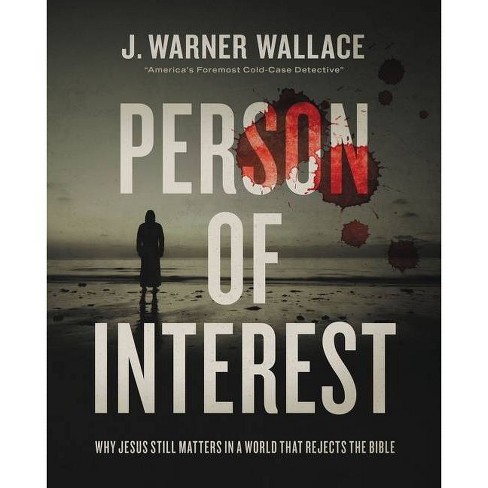Person Of Interest Book Review
{Full Disclosure: I was given an Advanced Reading Copy of this book by the publisher, but was under no obligation to review it. I had planned to order and read it anyway and would have done this review even if I had to purchase my own copy.]
What if we lost every copy of the New Testament we currently have? What if all the manuscripts were destroyed? What would we know about Jesus? Would we even think he had existed? Can we know anything about him apart from what Matthew, Mark, Luke, and John wrote down? These are the types of questions J. Warner Wallace attempts to answer in his latest book, Person of Interest.
One of the hardest types of cases to solve is a cold-case homicide with no body and no crime scene. A detective has to put his or her skills to the test to first determine if the person simply left voluntarily or if there was foul play, and then gather evidence to prove it.
Former cold-case homicide detective J. Warner Wallace is all too familiar with these types of investigations. In Person of Interest, he uses the techniques he developed in solving a real homicide of this nature and asks this question regarding the life of Jesus: What if we lost the primary source documents for the life of Jesus of Nazareth? What would we know about him? If every copy of the New Testament were destroyed, would we even think that he had existed?
Being able to engage in conversation without referring to the Bible is often an important first step. Most nonbelievers don’t have a very high view of the Bible – even for its historical value. So, as soon as you use it as a source, the conversation may come to a screeching halt. I’ve often been challenged by people to show them sources outside of the Bible for the things inside of it.
Can we do that? Can we talk about Jesus without having to refer to the New Testament? Can we look to other sources and arenas of life to show that he is someone worth looking into? Wallace certainly thinks so.
The Jesus Explosion
It’s hard for even unbelievers to deny the impact that Jesus of Nazareth had on history. 2000 years later, and he still influences the lives of billions of people across the globe. History is full of music about him, stories about him, characters influenced by him, paintings about him, structures built towards him, and much more. Whether you call it BC or BCE, AD or CE, the dividing point between the two eras is still the birth of Jesus.
As an atheist, J. Warner Wallace didn’t deny that Jesus had existed. But he started to ask questions. Like, just how big of an impact did Jesus have on history? And were there events that led up to his coming that uniquely pointed to him and no one else? What kind of impact have other wise men throughout history had? Are they anything to the same scale as Jesus?
The Fuse
Throughout the course of this book, Jim weaves in an actual case he worked on with his investigation into the life of Jesus. Using the techniques he developed in missing persons cases, Jim examines what we could know about Jesus if the New Testament went missing.
Without a body, Wallace had to come at this investigation a little differently. To make his case, Jim thought of the moment the victim went missing like a bomb going off. With any bomb, before it explodes, the fuse is lit. In an investigation, these are all the things that happened before the person went missing. Investigators need to find out what type of person she was, what her relationships were like, and what activities she was up to before she went missing. And why did she go missing when she did? Why not earlier? Or later?
Jim asked the same types of questions regarding the life of Jesus. Why did he show up when he did? If he had come a thousand years earlier, would the explosion have been as big? What if he came now for the first time instead of 2000 years ago? Why didn’t he come as soon as Adam and Eve fell? Wouldn’t that have fixed everything right away and saved the world a whole lot of heartbreak?
Another thing Jim did was to survey the various beliefs and stories of the people groups before Jesus came. He tried to see if they had any common threads. This is an approach that interested me a lot. As I read more and more, I’ve started to see many different people trying to answer the same big questions. Also, there are many common threads regarding humanity in stories – namely that there is a transcendent force that created everything, humanity is fallen/corrupted/imperfect, and, at some point, will be judged.
Also, look at some of the traits given to the heads of ancient myth and that we give to many heroes in our stories. Things like the coming of our hero being predicted by prophecy, the hero being born of unnatural means, being protected as an infant until he/she reached their full potential, having to face a test of character, being put on trial – all of these are things that show up in the ancient cultures before the coming of Jesus. Many of these traits are embodied in the historical person of Jesus of Nazareth. It’s as if people had in them the idea of what the story of a hero would look like before he came. And, these threads are woven into countless works of fiction that came after his death as well.
The Fallout
After an explosion occurs, there is a fallout to deal with: the aftermath. In the case of Jim’s murder investigation, these were the types of things the person of interest did after his wife went missing. He told investigators that she probably ran off, yet he got rid of her stuff shortly after she went missing. He got a new girlfriend and moved her in. He didn’t seem too interested in trying to find his missing wife. He lived a life that spoke very strongly that his missing wife wasn’t coming back.
Jesus In Literature
For his investigation into the life of Jesus, J. Warner looked at several areas of culture to see where he could find the fallout of Jesus’ coming. And, as any good investigator does, he started asking questions. Did anyone besides the New Testament authors write about Jesus? What could we learn about him from them? How many books have been written about him compared to other important historical figures?
Jesus in The Arts
Next, Jim turned his attention to the arts. He looked into things like music, sculptures, paintings, and architecture, and asked similar questions. How much music has been about Jesus or mentioned Jesus? What kinds of things could we learn about Jesus if all we had were the paintings of scenes from the Bible? What was the motivation of the musicians who wrote songs about him?
Before becoming a cop, Jim was an architect. So, he noticed another unique pattern of the early church. When Christianity first started, Christians had to meet in small, modest homes. Now, churches are some of the most beautiful pieces of architecture in the world. Why is that? What inspired churches to move from nondescript homes to the soaring architecture we so often see now?
Jesus In Education
Sometimes, Christians can be portrayed as people who don’t think very deeply about things. In recent years, Christians have begun homeschooling their kids. When parents choose to homeschool, it may seem that they are trying to shelter their children from the real world, as if they want to keep them in the dark about certain things. As Jim shows, though, this couldn’t be further from the truth.
In the book, Jim shows how Jesus encouraged a life of the mind, how Christians are called to study and then teach the next generation of Christ-followers. Education was very important to Jesus and the early church. In fact, for the first few centuries, Jews and Christians were often known as the “People of the Book”.
Christians began starting schools, and monasteries began building libraries of both Christian and non-Christian literature. They also began copying them by hand to increase and share copies of these works.
Within a few centuries, what we would consider universities began to be established – the University of Bologna (1088 CE), Oxford (1086 CE), and the University of Paris (1150 CE). All of these were established by Christians and would become the model for dozens and dozens of other universities in Europe. And these are the universities that would give birth to the scientific revolution in the 16th century (more on that later).
Many of the inventions and concepts that helped education explode beginning in the 15th century came from Christ-followers because they saw how important education was. The printing press – which made literature much more affordable and prevalent to the masses, organized public education, making education accessible to the poor, the idea of universal, fundamental education of children, and the education of those with disabilities. All of these ideas were championed by Christians. In fact, sign language and Braille were both invented by Christians so that they could educate those with disabilities.
Jesus in the Sciences
Out of all of the disciplines – philosophy, art, math, technology, etc – science is the one that most people give the most weight to when it comes to finding the truth about the world around us. And, because Christians believe a few things that are not popular in the scientific community, they are often looked at as being unscientific. Which, in today’s world, means they are truth deniers.
But Jim shows how several Christian concepts about the world led to the explosion in scientific knowledge that we have today. Concepts like the world being the product of a singular, orderly, and rational God, as opposed to the erratic and imperfect pantheistic gods of the ancient world. And it was the Christian scientists’ desire to worship God that motivated them to discover the natural world around them. Remember earlier when we talked about education at the universities? Christians added the study of science to the universities in order to educate people on the world around them as a form of worshiping their Creator. These universities would become the birthplace of the scientific revolution.
In Jim’s book, he goes through the trouble of listing all of the various Mothers and Fathers of various disciplines – like the Father of Modern Physics, the Father of Modern Oceanography, and the Father of Hydraulics. Given the popular impression of the relationship between Christians and science, you would think this would be a short list. But Jim’s book has 7 pages of disciplines that have been founded or co-founded by Christian scientists. No other worldview even comes close to that number.
On The Book
I wanted to comment on some of the ways this book is put together. First off, let’s talk about the diagrams. With his background in architecture and the arts, Jim has always added well-designed illustrations to his works that help visualize the data he is putting forth and the point he is trying to make. This book is full of illustrations. More than any of his other works.
As an evidentialist, Jim wants to put as much data forth as possible in order to make his case. The amount of time that had to go into this book was evident from the beginning. Jim packs a ton of references, names, places, events, etc, to make his case and show just how uniquely qualified Jesus was to be our person of interest. There is so much evidence packed into each point he makes that at times I felt like saying, “ok, Jim. I get it already!”
The final thing I want to highlight is the bibliography – what Jim refers to as his Case Notes. There are 53 pages of references listed. That, my friends, is an incredibly thorough amount of research. Jim backs up every assertion he makes with his sources, so you can go check him on it if you want to.
Keep in mind that this is more than just a big book of facts. In the book, Jim shares two investigations he conducted. The first is the “no body missing” cold case, and the second is part of the investigation he did to determine if Christianity was true or not. The whole book unfolds much like the police procedural dramas that are so popular on TV – we just happen to learn an awful lot along the way.
How This Book Can Help You
Many of us want to engage in discussions about Jesus with our non-Christian friends, but can’t find good inroads. More often than not, they aren’t interested in what the Bible has to say about anything. But, wouldn’t it be great if we could meet them at the places they are interested in? What if we could find a way to engage through things like art, their favorite TV shows and movies, music, education, or the sciences? These are areas people are passionate about or spend their time working in. What if we could teach them about Jesus from where they are instead of starting where we are?
Person of Interest will help you do that. This book will help you see just how big an impact Jesus has had on every aspect of our modern world. The amount of evidence that points back to him is staggering. And, after reading this book, you can help your non-believing friends see why Jesus is someone still worth thinking about.
Share This Story, Choose Your Platform!
latest video
news via inbox
Subscribe and never miss an update!







